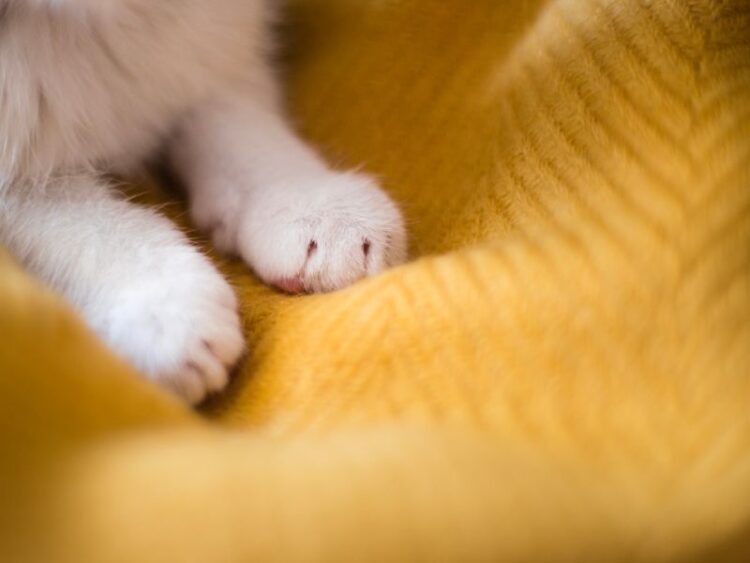might knead you with their paws, pushing in and out as if they’re working dough. This behavior can be endearing, puzzling, and often leads to the question: why does my cat make biscuits on me? In this article, we’ll explore the reasons behind this delightful behavior, its implications for your cat’s well-being, and what it means for your bond with your furry companion.
Understanding the Behavior: A Historical Perspective
To understand why cats knead, it’s important to delve into their history. Kneading, or “making biscuits,” is believed to be an instinctual behavior that stems from kittenhood. When kittens nurse from their mothers, they knead their mother’s belly with their paws to stimulate milk flow. This action is comforting and provides a sense of security for the kittens. As they grow, this behavior often carries over into adulthood, manifesting itself in various contexts.
Kneading as a Kitten
When a kitten kneads, it not only aids in milk extraction but also provides comfort. The warmth and rhythmic motion help establish a bond with their mother, fostering emotional security. This association between kneading and comfort often translates into adulthood, where cats may knead on soft surfaces, including their owners, as a way to recreate the safety and affection they experienced as kittens.
The Comfort Factor: Why Cats Knead on Humans
One of the most common reasons cats knead on humans is to seek comfort. If your cat hops onto your lap and starts making biscuits, it could mean they feel safe and secure in your presence. This behavior can be seen as a form of affection and trust. When a cat kneads on you, they may be expressing their love and appreciation for the bond you share.
A Sign of Affection
When a cat kneads you, it’s often a sign that they view you as part of their family. Kneading releases endorphins, which are hormones that create feelings of pleasure and relaxation. Just like how humans find comfort in certain rituals, such as a warm hug or a cozy blanket, cats find solace in kneading their humans.
Marking Territory
In addition to seeking comfort, kneading can also be a way for cats to mark their territory. Cats have scent glands located in their paws, and when they knead, they release pheromones that signal to other animals that this is their space. By kneading on you, your cat may be asserting their claim to you as their human, which further emphasizes the bond you share.
Kneading as a Stress Reliever
Cats, like humans, can experience stress and anxiety. Kneading can serve as a self-soothing mechanism for cats. When they knead, they may be attempting to alleviate feelings of tension or discomfort. For instance, if your cat is feeling anxious due to changes in their environment (like a new pet, moving houses, or loud noises), they may knead more frequently as a way to calm themselves.
Creating a Safe Space
In this context, kneading can be seen as a way for cats to create a safe and comforting environment. By kneading on you, they are not only seeking your warmth and affection but also attempting to establish a sense of control in a potentially stressful situation. This behavior can be especially prominent in cats who have had traumatic experiences in their past or those who are more prone to anxiety.
Age and Experience: Factors Influencing Kneading Behavior
While all cats may knead, certain factors can influence how frequently and intensely they engage in this behavior. These factors include age, socialization, and individual personality traits.
Kittens and Young Cats
Kittens and young cats are more likely to knead as they are still learning about their environment and establishing their comfort zones. They often display this behavior with their mother and siblings, and it may carry over into their interactions with humans. As they grow, they may continue to knead as a way to bond with their owners.
Adult Cats
Adult cats may knead less frequently, but when they do, it can be an even more pronounced expression of comfort and affection. Their kneading may be more focused, and they may choose specific spots where they feel most secure, such as a favorite blanket or your lap.
Personality Factors
Just like humans, each cat has its unique personality. Some cats are naturally more affectionate and prone to kneading than others. Cats that have been socialized well from a young age may exhibit more kneading behavior as they have learned to trust humans and view them as companions.
The Ideal Surface for Kneading
Cats have preferences when it comes to the surfaces they knead. You may have noticed that your cat often kneads on soft materials like blankets, pillows, or your lap. This preference is not merely coincidental; it ties back to their instinctual behavior.
Softness and Texture
Soft surfaces mimic the feeling of their mother’s belly, providing a sense of comfort and security. A plush blanket or your warm lap can evoke feelings of safety, prompting your cat to knead. Some cats might even knead on items that smell like their owners, further reinforcing the emotional connection.
Exploring Different Textures
Cats are curious creatures, and they may knead on various surfaces to explore different textures. If you’ve ever caught your cat kneading on your couch or a cat tree, they’re likely indulging in a sensory experience that satisfies their natural instincts.
When Kneading Becomes Problematic
While kneading is generally a positive behavior, there are instances where it can become problematic. If your cat’s kneading becomes excessive or leads to unwanted behaviors, it might be time to address the issue.
Overstimulation
Some cats may become overstimulated while kneading, leading to excessive biting or scratching. If your cat begins to nip at you or show signs of aggression while kneading, it’s essential to gently redirect their behavior. You can try providing a dedicated kneading surface, such as a soft blanket or cat bed, to help them channel their instincts appropriately.
Paws and Claws
Kneading can also lead to issues with claws. Cats have sharp claws that can cause discomfort, especially when kneading on bare skin. If your cat tends to knead too hard or if you find their claws snagging on your clothes, consider keeping their nails trimmed or providing them with a designated kneading surface that protects your skin.
Encouraging Positive Kneading Behavior
If you enjoy the kneading behavior but want to ensure it remains a positive experience for both you and your cat, there are steps you can take to encourage healthy kneading habits.
Create a Comfortable Environment
Ensure that your cat has access to soft, cozy surfaces where they can knead without discomfort. Provide a variety of blankets, pillows, or cat beds to create a kneading haven. Having multiple options will allow them to choose the surface that makes them feel most secure.
Rewarding Affectionate Behavior
When your cat kneads on you, reinforce the behavior with positive reinforcement. Offering treats, gentle praise, or extra petting can help your cat associate kneading with positive outcomes. This encouragement can enhance the bond between you and your feline companion.
Understanding Individual Differences in Kneading
Every cat is unique, and their kneading behavior can vary widely. Some cats may knead frequently, while others may engage in this behavior occasionally. Understanding your cat’s individual preferences and behaviors will enhance your relationship and help you provide them with the comfort they seek.
Observe and Adapt
Take the time to observe your cat’s kneading habits. Notice when they knead, how long they do it, and what surfaces they prefer. By understanding their preferences, you can adapt your interactions to better suit their needs.
Consult with a Veterinarian
If you have concerns about your cat’s kneading behavior, especially if it seems excessive or leads to aggression, consider consulting with a veterinarian or animal behaviorist. They can provide insight into your cat’s behavior and offer strategies for addressing any potential issues.
Conclusion: A Beautiful Bond
Kneading is a charming and instinctual behavior that reflects the deep bond between you and your cat. Whether it’s a reminder of their kittenhood or a way to seek comfort and affection, making biscuits is an integral part of feline behavior. By understanding the reasons behind this behavior and providing a supportive environment, you can nurture the connection you share with your furry companion.





